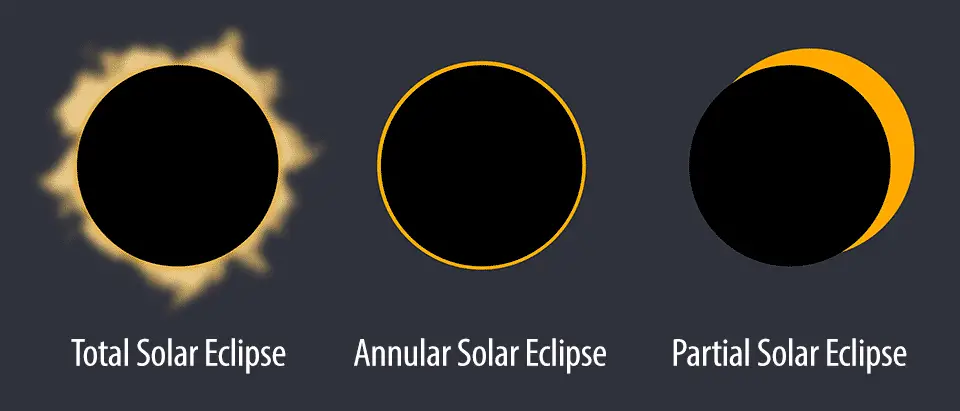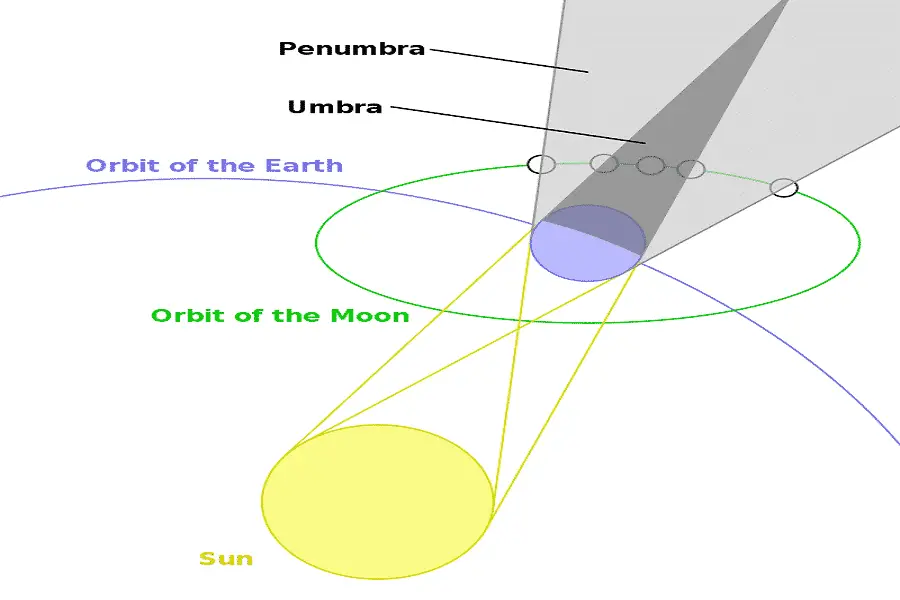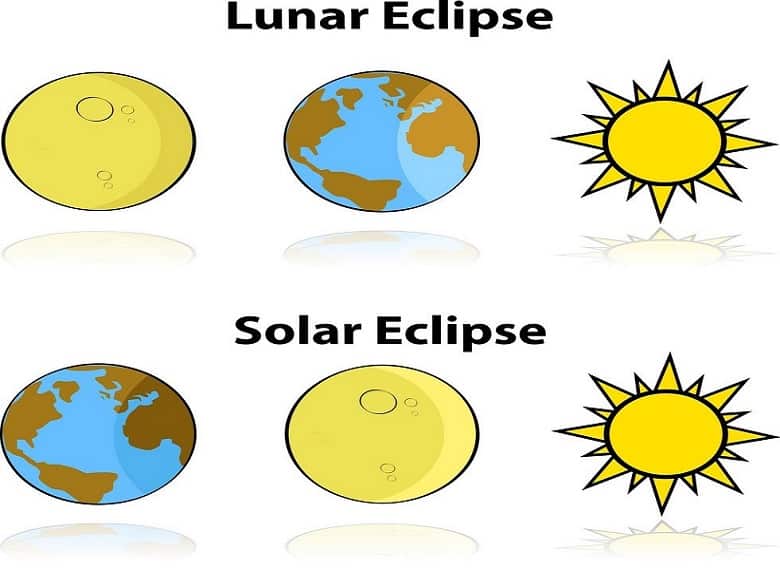When the sun gets darker, we call it a solar eclipse. On the contrary, when the moon gets darker, we call it a lunar eclipse. There are so many types of solar and lunar eclipse, depending on the fact of how much of the sun or moon is obscured by another celestial object.
But, before going deep into these kinds of questions like how much of a sun or a moon gets darker and by what astronomical phenomena. Let me present you with a quick review regarding the basic difference between solar eclipse and lunar eclipse. Keep reading for a proper understanding of the subject.
Editor’s Choice: Full Moon in November – Beaver Moon or Flower Moon?
Difference Between Solar and Lunar Eclipse
| Solar Eclipse | Lunar Eclipse | |
| 1. | A solar eclipse occurs when the moon comes between the earth and the sun. | A lunar eclipse occurs when the earth comes between the moon and the sun. |
| 2. | Only on a new moon day, a solar eclipse can occur. | Only on a full moon day, a lunar eclipse can occur. |
| 3. | The eclipse of the sun takes place during the daytime. | The eclipse of the moon takes place during the nighttime. |
| 4. | The duration of a solar eclipse is at most between 5 to 10 minutes. | The duration of the lunar eclipse is at least 1 hour. |
| 5. | An eclipse of the sun is typically observed somewhere between 2 to 5 times a year. | An eclipse of the moon is typically observed somewhere between 2 to 5 times a year. |
| 6. | It can only be observed in a few places. | It can easily be observed in many places. |
| 7. | Avoid seeing the solar eclipse with the naked eye. | Enjoy a glimpse of the lunar eclipse with the naked eye. |
What are Eclipses?
According to the astronomical definition of the eclipse, an eclipse occurs when one celestial object comes between the other two celestial objects. There are two types of eclipses. These are solar and lunar eclipses.
Not to mention, depending on the fact that how much a celestial object obscures another celestial object, the solar and lunar eclipse can be further bifurcated into many parts.
Must Read: The Science Behind The Solar Eclipse
What is a Solar eclipse?
A solar eclipse occurs when the moon comes between the sun and the earth. Therefore, obstructing the sunlight from falling on the surface of the earth. Moreover, this natural phenomenon can only occur on the eve of the new moon day.
Just because the size of the moon is so small compared to the size of the sun, an eclipse of the sun can only occur for a few minutes.
Types of Solar Eclipses

Depending on the fact that how much moon is obscuring the sunlight from falling on the earth, it can be further bifurcated into four types.
Total Solar Eclipse
A total solar eclipse occurs when the moon blocks out the sun’s disk entirely. And, for that to happen, the moon has to be near its perigee i.e the closest distance of the moon from the earth.
Not to mention, during the solar eclipse totality, the magnitude of the eclipse is greater than or equal to 1.
Annular Solar Eclipse
An annular solar eclipse occurs when the moon does not block out the sun’s disk entirely. In other words, it only covers the central part of the sun’s disk, leaving the sun’s outer edge to form a thin ring of fire.
And, for that to happen, the moon has to be near its apogee i.e the farthest distance of the moon from the earth. Not to mention, during the annular solar eclipse, the magnitude of the eclipse is less than 1.
Partial Solar Eclipse
As the name suggests, a partial solar eclipse occurs when the moon partially blocks the sunlight from falling on the earth.
Moreover, just because the visibility of the partial solar eclipse varies, the magnitude of the partial solar eclipse does not have any fixed value.
Hybrid Solar Eclipse
A hybrid solar eclipse is nothing but a combination of the total and the annular solar eclipse. To put it differently, at one location, a hybrid kind of solar eclipse looks like a total solar eclipse.
As a result, the magnitude of the eclipse becomes greater than or equal to 1. On the other hand, at some other locations, it looks like an annular solar eclipse. Therefore, as a result, the magnitude of the solar eclipse becomes less than 1.
Editor’s Choice: Top 6 Solar Eclipse Facts you don’t Wanna Miss
Occurrence of Solar Eclipse
A solar eclipse normally occurs somewhere between 2 to 5 times a year. In fact, as per the available astronomical writings of the past century, the earth encounters an average of 2.4 eclipses of the sun every year.
Well, if I talk about the recent and upcoming solar events, here is a list of some of the recent and upcoming solar eclipses.
Recent Solar Eclipses
- Total Solar Eclipse (4 December 2021)
- Partial Solar Eclipse (30 April 2022)
- Partial Solar Eclipse (25 October 2022)
Upcoming Solar Eclipses
- Hybrid Solar Eclipse (20 April 2023)
- Annular Solar Eclipse (14 October 2023)
- Total Solar Eclipse (08 April 2024)
What is a Lunar Eclipse?
A lunar eclipse occurs when the earth comes between the moon and the sun. Therefore, as a result, the earth’s shadow obstructs the sunlight falling on the surface of the moon.
Moreover, this natural phenomenon can only occur on the eve of the full moon day. Just because the size of the earth is too big compared to the size of the moon, an eclipse of the moon can occur for more than 1 hour.
Editor’s Choice: 8 Lunar Phases – From New Moon to Full Moon to New Moon
Types of Lunar Eclipses

Depending on the fact that how much earth is obscuring the sunlight from falling on the moon, it can be further bifurcated into three types.
Total Lunar Eclipse
A total lunar eclipse occurs when the moon completely passes through the earth’s umbra. Not to mention, an umbra is the darkest part of the earth’s shadow.
Therefore, when the moon is completely immersed in the earth’s umbra, the umbra covers the entire surface of the moon. Moreover, the total eclipse of the moon is also known as the blood moon.
Partial Lunar Eclipse
As the name suggests, a partial lunar eclipse occurs when the moon partially passes through the earth’s umbra.
Penumbral Lunar Eclipse
Penumbral Lunar Eclipse A penumbral lunar eclipse occurs when the moon passes through the earth’s penumbra. Not to mention, a penumbra is the lightest part of the earth’s shadow.
Occurrence of Lunar Eclipse
Well, both the solar and lunar eclipse occurs somewhere between 2 to 5 times a year. On the other hand, if I talk about the recent and upcoming lunar events, here is a list of some of the recent and upcoming lunar eclipses.
Recent Lunar Eclipses
- Partial Lunar Eclipse (19 November 2021)
- Total Lunar Eclipse (16 May 2022)
- Total lunar eclipse (08 November 2022)
Upcoming Lunar Eclipses
- Penumbral Lunar Eclipse (5 May 2023)
- Partial Lunar Eclipse (28 October 2023)
- Penumbral Lunar Eclipse (25 March 2024)
Editor’s Choice: Why my top 6 Lunar Eclipse Facts are BETTER than Yours?
Frequently Asked Questions
1. What phase is the moon in during a solar eclipse?
ANS: A solar eclipse can only occur on a new moon day.
2. Does a solar eclipse occurs on every new moon day?
ANS: Just because the moon’s orbital path has an axial tilt of approximately 5° with respect to the earth’s orbital plane. Therefore, a solar eclipse does not occur on every new moon day.
3. What phase is the moon in during a lunar eclipse?
ANS: A lunar eclipse can only occur on a full moon day.
4. Does a lunar eclipse occurs on every full moon day?
ANS: For the same reason mentioned above, a lunar eclipse does not occur on every full moon day.
That’s it for this post. If you like this article, share it if you like, like it if you share it. You can also find us on Mix, Twitter, Pinterest, and Facebook. Hey man, If you have come this far, do give us feedback in the comment section. It would make my day. You can also make a donation. Your donations will help us to run our website and serve you BETTER. Cheers!!!
You might also like:
- Indeed, the moon is moving away from earth, BUT WHY?
- Hence, That’s How Was The Moon Formed…!!!
- Why Can’t We See The Dark Side of The Moon?

I’m still learning from you, but I’m trying to achieve my goals. I certainly love reading everything that is written on your site. Keep the tips coming. I loved it!
Thanx! Keep visiting us…!!!
Thanks for so much information I never knew so much about the differences between the two eclipse.
Thank you again and keep up the great work.
Deborah James
Thnxx Deborah, keep visiting us…!!!